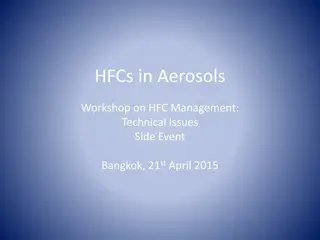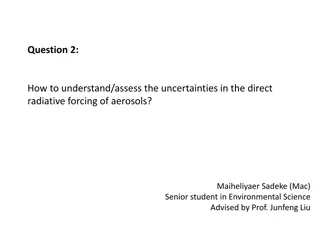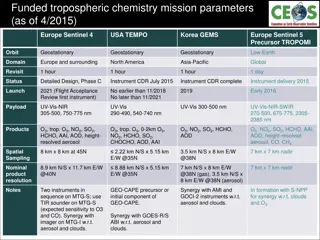Standard Precautions in Dental Settings
Standard Precautions in Dental Settings emphasize the importance of hand hygiene, proper use of personal protective equipment, aseptic techniques, clinical asepsis, and environmental surface disinfection to control infections. Adherence to these precautions minimizes the risk of spreading microorgan
0 views • 21 slides
Medication and Pharmacy Vocabulary
This content provides essential information about drug abuse, medication vocabulary, dosage, effects, pharmacy, and administration of medicines. It covers terms like prescription, instruction, dose, effect, precaution, pharmacy, pharmacist, pharmaceutical, and common actions related to medication us
1 views • 27 slides
Pharmaceutical Aerosols: Components and Advantages
Pharmaceutical aerosols are pressurized systems used for delivering therapeutic active ingredients. They consist of components like propellants, containers, valves, and product concentrate. The use of aerosols offers advantages such as targeted delivery, reduced irritation, and ease of application.
2 views • 37 slides
Colloids and Their Importance in Pharmaceuticals
Colloids play a vital role in the pharmaceutical industry as heterogeneous biphasic systems with particle sizes ranging from 1nm to 100nm. They are classified based on aggregation and interaction of phases, with examples like aerosols, foams, emulsions, and more. Colloids can be prepared by condensa
0 views • 23 slides
Importance of Ventilation in the Workplace Environment
Adequate ventilation plays a crucial role in reducing the risk of virus transmission, particularly aerosols, in enclosed areas like workplaces. This presentation highlights the significance of ventilation and how health and safety representatives can collaborate to address concerns. It also discusse
1 views • 20 slides
States of Matter and Properties of Gases
Matter can be classified into gas, liquid, and solid based on particle arrangement, shape, and motion. Gases in pharmacy are crucial for various applications like anesthesia and aerosols. Properties of gases include compressibility, pressure exertion, diffusion, and expansion. Gas laws such as Boyle
0 views • 22 slides
Risk Mitigation Strategies for Church Choirs
The article discusses risk mitigation strategies for church choirs in the context of the COVID-19 pandemic. It highlights notable outbreaks related to choral singing, findings from studies on bioaerosol emissions, and the importance of prioritizing safety to prevent illness and casualties within cho
0 views • 16 slides
Chemistry in the Arctic: CHACHA Project Overview
The CHACHA Project is a collaborative research initiative involving six institutions to study Arctic chemistry in relation to sea ice loss and fossil fuel extraction. The team aims to assess how these environmental changes impact halogen, nitrogen, and sulfur chemistry, with a focus on aerosols and
0 views • 6 slides
Light Optical Aerosol Counter (LOAC) Project Overview
Light Optical Aerosol Counter (LOAC) is a project led by Jean-Baptiste Renard in France, involving a collaboration between research institutions, private companies, and the French Space Agency. The LOAC instrument, weighing 1 kg, is used with meteorological balloons to measure concentrations of aero
0 views • 21 slides
Aerosol Microphysics and Aqueous Phase Chemistry in Atmospheric Research
This material delves into the study of aerosol microphysics and aqueous phase chemistry in the context of atmospheric research. It discusses topics such as scale-dependencies, obstacles in development, working groups for MUSICA, and the importance of various processes in aerosol modeling. The conten
0 views • 11 slides
Advancements in Chemical Mechanisms for Aerosol Effects in WRF/Chem Model
This study focuses on the development of a new chemical mechanism in the Weather Research and Forecasting with Chemistry (WRF/Chem) model to address the underestimation of carbonaceous aerosols. The RACM/MADE/SOA-VBS mechanism incorporates advancements in gas-phase chemistry and particle parameteriz
0 views • 12 slides
GOES-R ABI Aerosol Detection Product Validation Summary
The GOES-R ABI Aerosol Detection Product (ADP) Validation was conducted by Shobha Kondragunta and Pubu Ciren at the NOAA/NESDIS/STAR workshop in January 2014. The validation process involved testing and validating the ADP product using proxy data at various resolutions for detecting smoke, dust, and
1 views • 21 slides
Aerosols: Types, Applications, and Environmental Impact
Aerosols play a significant role in various industries and applications, utilizing different propellants and technologies. This workshop discussed the management of HFCs in aerosols, highlighting technical aspects and not-in-kind technologies. The aerosol sector encompasses consumer, technical, and
0 views • 26 slides
Global Warming Theory: Complexity and Uncertainty
Global warming theory presents three main propositions, with uncertainty arising from factors such as the industrial revolution's impact on CO2 levels, aerosols' cooling and warming effects, and measurement errors impacting data accuracy. Alternative arguments question traditional views on evolution
0 views • 13 slides
Laser Beam Propagation in Maritime Environment Study
Investigation and comparison of laser beam propagation in maritime environments through field and laboratory experiments. The study examines the effects of real-life conditions such as temperature fluctuations, wind, and aerosols on laser light propagation. A basic field experiment at the US Naval A
0 views • 11 slides
Climate Change, Biodiversity, and Sustainable Agriculture Programs at UFHB
CEA's programs at UFHB focus on climate change, biodiversity, and sustainable agriculture through research, training, and partnerships with international programs. The interdisciplinary approach addresses climate-health interactions, urban pollution modeling, and the impact of aerosols on West Afric
0 views • 10 slides
Uncertainties in Direct Radiative Forcing of Aerosols
The uncertainties in the direct radiative forcing of aerosols can be assessed by considering factors such as emissions, lifetime, Mass Absorption Cross Section (MAC), Aerosol Absorption Optical Depth (AAOD), and forcing efficiency. Variations in these factors contribute to the overall uncertainty in
0 views • 9 slides
Advanced Source Inversion Module of JRODOS Presentation at 5th NERIS Workshop
The presentation highlights the Advanced Source Inversion Module of JRODOS, focusing on its development, integration, and testing methodology for estimating emission rates and nuclide composition post a nuclear power plant accident. The test case involves a hypothetical accident at Rivne NPP in Ukra
0 views • 26 slides
MODIS/VIIRS Atmosphere Discipline Team Session - May 2023, College Park, MD
The MODIS/VIIRS Atmosphere Discipline Team hosted a session in May 2023 at College Park, MD, focusing on various aspects of atmospheric science. The session included presentations on aerosols, clouds, data access, continuity products, and new science products. Speakers discussed topics such as ambie
0 views • 4 slides
Climate System Response to Perturbations: Insights from Hugues Goosse's Chapter 4
Hugues Goosse's Chapter 4 delves into the response of the climate system to perturbations, emphasizing radiative forcing, greenhouse gases, aerosols, and their impacts on Earth's radiative budget. The chapter intricately describes physical feedbacks, interactions involving energy balance, hydrologic
0 views • 40 slides
North Atlantic Hurricane Drought and Aerosol Impact
This study explores the influence of sulfate aerosols on the late 20th-century North Atlantic Hurricane drought, focusing on the interaction of European sulfate aerosols and African dust. It investigates the radiative forcing effects and variability in hurricane activity, proposing hypotheses relate
0 views • 17 slides
Developments in Vertical Columns Inference for TEMPO NO2 Algorithm
The development of the TEMPO NO2 algorithm to infer vertical columns from total slant columns involves contributions from various experts, such as Randall Martin, Nick Krotkov, Lok Lamsal, Jintai Lin, Chris McLinden, and Caroline Nowlan. Attention is needed for the removal of stratospheric NO2 and a
2 views • 10 slides
Addressing the Harmful Impact of Gas-Powered Leaf Blowers on Public Health
Gas-powered leaf blowers (GLBs) are causing harm to public health and well-being, with many cities in the US implementing bans and restrictions due to their detrimental effects. Particularly in the context of COVID-19, the focus on lung health is crucial. Efforts are being made by activists like Mon
0 views • 31 slides
COVID-19 Risk and Spread in Childcare Settings
This content provides guidance on COVID-19 infection prevention and control in childcare settings by exploring risk factors, spread mechanisms, and the nature of the COVID-19 virus. It discusses the importance of aerosols and droplets, the lipid coat of the virus, and how the virus spreads through c
0 views • 35 slides
Comprehensive Overview of OSCAR v3.1: A Compact Earth System Model with CMIP6 Simulations
Showcasing the compact Earth system model OSCAR v3.1 and its CMIP6 simulations. OSCAR is a reduced-form Earth system model calibrated to emulate complex models, focusing on radiative forcing, temperatures, precipitation, ocean heat content, aerosols, ozone, and more. Historical periods and scenarios
0 views • 15 slides
Importance of 2019 Influenza Vaccination for Health Care Workers
Influenza, commonly known as the flu, is a contagious respiratory illness caused by influenza viruses that can spread through aerosols or surface contact. Common symptoms include fever, headache, fatigue, muscle pain, cough, and sore throat. The flu can be severe, leading to hospitalizations and eve
0 views • 19 slides
Inhalant Abuse: Risks, Effects, and Prevention
Inhalant abuse is a widespread issue, with volatile substances being inhaled to achieve psychoactive effects. This form of substance abuse poses significant toxicological and social hazards, often affecting marginalized populations such as neglected street children. The accessibility, affordability,
0 views • 44 slides
Analysis of Atmospheric Parameters and Transmission at OHP in 2018
This analysis focuses on the atmospheric parameters and transmission at the Observatoire de Haute-Provence (OHP) during 2018, with a specific emphasis on distinguishing between typical winter and summer conditions. The study utilizes MERRA2 data from January to August to examine pressure, precipitab
0 views • 16 slides
Funded Tropospheric Chemistry Mission Parameters Overview
Funded tropospheric chemistry missions like Europe Sentinel 4, USA TEMPO, Korea GEMS, and others aim to monitor atmospheric composition for air quality assessment. The missions involve advanced instruments to measure ozone, nitrogen dioxide, sulfur dioxide, aerosols, and more, with specific spatial
0 views • 9 slides




























